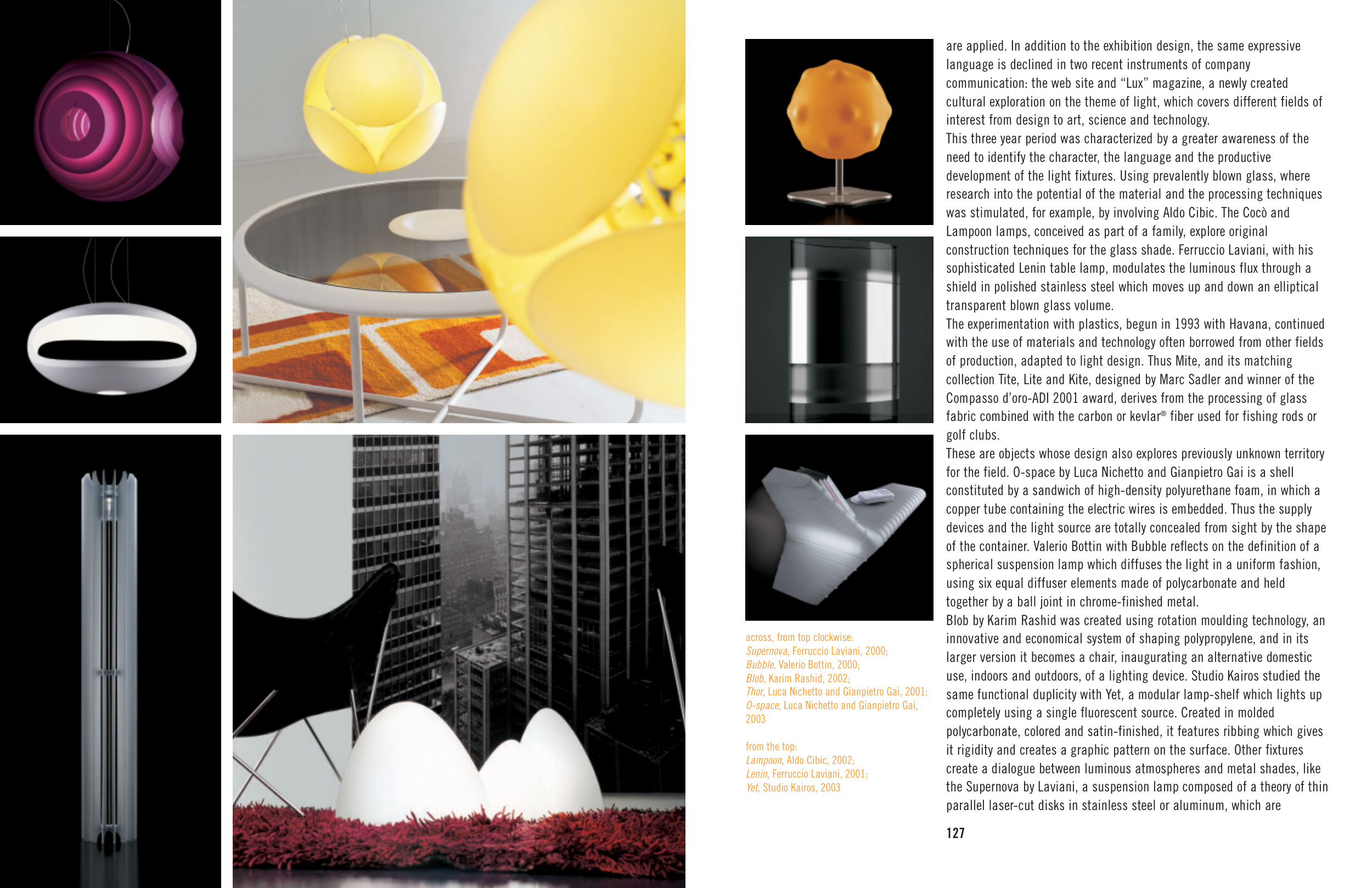127
are applied. In addition to the exhibition design, the same expressive
language is declined in two recent instruments of company
communication: the web site and “Lux” magazine, a newly created
cultural exploration on the theme of light, which covers different fields of
interest from design to art, science and technology.
This three year period was characterized by a greater awareness of the
need to identify the character, the language and the productive
development of the light fixtures. Using prevalently blown glass, where
research into the potential of the material and the processing techniques
was stimulated, for example, by involving Aldo Cibic. The Cocò and
Lampoon lamps, conceived as part of a family, explore original
construction techniques for the glass shade. Ferruccio Laviani, with his
sophisticated Lenin table lamp, modulates the luminous flux through a
shield in polished stainless steel which moves up and down an elliptical
transparent blown glass volume.
The experimentation with plastics, begun in 1993 with Havana, continued
with the use of materials and technology often borrowed from other fields
of production, adapted to light design. Thus Mite, and its matching
collection Tite, Lite and Kite, designed by Marc Sadler and winner of the
Compasso d’oro-ADI 2001 award, derives from the processing of glass
fabric combined with the carbon or kevlar® fiber used for fishing rods or
golf clubs.
These are objects whose design also explores previously unknown territory
for the field. O-space by Luca Nichetto and Gianpietro Gai is a shell
constituted by a sandwich of high-density polyurethane foam, in which a
copper tube containing the electric wires is embedded. Thus the supply
devices and the light source are totally concealed from sight by the shape
of the container. Valerio Bottin with Bubble reflects on the definition of a
spherical suspension lamp which diffuses the light in a uniform fashion,
using six equal diffuser elements made of polycarbonate and held
together by a ball joint in chrome-finished metal.
Blob by Karim Rashid was created using rotation moulding technology, an
innovative and economical system of shaping polypropylene, and in its
larger version it becomes a chair, inaugurating an alternative domestic
use, indoors and outdoors, of a lighting device. Studio Kairos studied the
same functional duplicity with Yet, a modular lamp-shelf which lights up
completely using a single fluorescent source. Created in molded
polycarbonate, colored and satin-finished, it features ribbing which gives
it rigidity and creates a graphic pattern on the surface. Other fixtures
create a dialogue between luminous atmospheres and metal shades, like
the Supernova by Laviani, a suspension lamp composed of a theory of thin
parallel laser-cut disks in stainless steel or aluminum, which are
across, from top clockwise:
Supernova, Ferruccio Laviani, 2000;
Bubble, Valerio Bottin, 2000;
Blob, Karim Rashid, 2002;
Thor, Luca Nichetto and Gianpietro Gai, 2001;
O-space, Luca Nichetto and Gianpietro Gai,
2003
from the top:
Lampoon, Aldo Cibic, 2002;
Lenin, Ferruccio Laviani, 2001;
Yet, Studio Kairos, 2003


